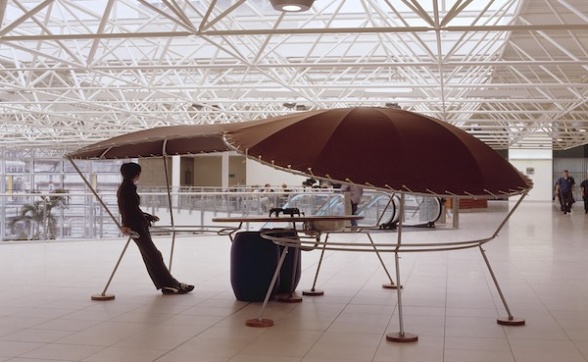Dré Wapenaar
Dré Wapenaar, Coffee Stand, 1998
Dré Wapenaar (b. 1961, Berkel en Rhodenrijs, The Netherlands) is a sculptor whose practice since 1994 has been perhaps closer to architecture in that it is based on an acute responsiveness to particular situations. He has worked increasingly with tent structures, making highly ecological and economic shelter provisions in beautiful and appropriate shapes for urban and rural settings. He has designed a wide variety of tents, including a flower kiosk, a BBQ tent, a newspaper stand, a tent for tree-lovers and, most recently, a Death Bivouac and a Birth Tent.
After visiting Liverpool, Dré Wapenaar proposed that he should design a shelter for Church Alley, outside the Bluecoat Arts Centre, a recognised ‘pitch’ from which homeless people sell The Big Issue magazine. The I-Stand he designed was open at the sides and seated three people placed so as to encourage conversation. Once drawings for the prototype were available, a meeting with the distributors of The Big Issue was arranged in order to open a dialogue with the sellers. At this point, however, the magazine editors advised the International 2002 exhibition that it would be unwise to proceed with the commission, in view of the intense competition between sellers for ‘pitches’.
I-Stand was especially pertinent since the City Council had been in discussion over a number of years with the city centre street traders in an attempt to regularise their trade and enhance the visual appearance of the trading stands. I-Stand would have contributed to this discussion by example. Wapenaar’s sculptures were designed as multiples: the intention was to produce as many I-Stands as funds would allow.
After abandoning the production of I-Stand but in view of the significance and topicality of the proposal, the International 2002 invited Wapenaar to exhibit an existing work, Coffee Stand. Since the original import of coffee to Europe, the drink has been an accompaniment to conversation, and often to intense political debate. As an alternative model to the existing mobile and temporary snacks and drinks bars in Liverpool, Coffee Stand encouraged a debate into how the design of vending stands contributes to the quality of life in the city.
This discussion was also concerned with the mechanisms for control of the quality of the urban environment. Wapenaar’s interventions raise the question as to whether the design of public spaces should reflect the actual uses to which those spaces are put, even if those uses – Big Issue sellers as well as coffee sellers – are not normally associated with the ‘civic’. Imaginative street furniture that accounted for buggies, children, street vendors, buskers, pets, shopping trolleys and bags (not just adults wanting to sit down) could contribute significantly to the pleasure of the urban space and become part of a real, physical dialogue between citizens and city.
Dré Wapenaar at Liverpool Biennial 2002
Coffee Stand, 1998
Mixed Media
Courtesy of the Artist
Exhibited at the Echo and Daily Post Building, Old Hall Street
Supported by
The Mondriaan Foundation, Amsterdam
The Northwest Development Agency.
Liverpool Biennial
55 New Bird Street
Liverpool L1 0BW
- T +44 (0)151 709 7444
- info@biennial.com
Liverpool Biennial is funded by
Founding Supporter
James Moores
